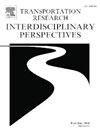Mode choice modeling of electric air taxis for long-distance airport trips
IF 3.9
Q2 TRANSPORTATION
Transportation Research Interdisciplinary Perspectives
Pub Date : 2025-04-17
DOI:10.1016/j.trip.2025.101421
引用次数: 0
Abstract
As congestion and environmental concerns grow, innovative solutions like electric air taxis (EATs) are gaining attention as efficient and sustainable options for improving airport trips. To understand preferences for EATs for long-distance airport access/egress trips, we conducted a stated choice experiment and estimated integrated choice and latent variable (ICLV) models. The study analyzed choices among EAT, private vehicle (PV), public transport (PT), and transportation network companies (TNC), collecting data in 2024 from 1028 US adults traveling 75–200 miles one-way to/from airports. In-vehicle travel time, travel cost, and access time for all modes showed significant negative associations with mode choice, with access time being particularly critical for EAT. A decrease in service frequency of EAT significantly reduced its selection odds, and autonomy in travel modes was found to present a disutility, with the most substantial negative impact on EAT. Perceived ease of use was highest for EAT, while perceived trust was highest for PT. Travelers were more inclined to choose EAT when it is perceived as dependable and reliable. Including luggage costs in the total travel cost for EAT significantly increased preferences compared to scenarios with extra fees. Based on our findings, the highest value of travel time savings (VTTS) was for EAT at $46.09/hr, followed by PV at $38.63/hr, PT at $37.81/hr, and TNCs at $30.40/hr. EAT’s access time VTTS was highest, at $53.46/hr. These findings provide valuable insights for airlines, airport operators, EAT companies, and policymakers regarding the market potential of EATs for long-distance airport trips.
电动空中出租车长途机场出行的模式选择模型
随着交通拥堵和环境问题的日益严重,电动空中出租车(EATs)等创新解决方案作为改善机场旅行的高效和可持续选择正受到关注。为了了解长途机场进出行程中交通工具的偏好,我们进行了陈述选择实验,并估计了综合选择和潜在变量(ICLV)模型。该研究分析了EAT、私家车(PV)、公共交通(PT)和交通网络公司(TNC)的选择,收集了2024年1028名单程往返机场75-200英里的美国成年人的数据。所有模式的车内旅行时间、旅行成本和访问时间与模式选择呈显著负相关,访问时间对EAT尤为重要。服务频率的降低显著降低了出行方式的选择几率,出行方式的自主性呈现出负效用,对出行方式的负面影响最为显著。感知易用性最高的是EAT,而感知信任度最高的是PT。当旅行者认为EAT可靠时,他们更倾向于选择EAT。与有额外费用的情况相比,将行李费用纳入EAT的总旅行费用显著增加了人们的偏好。根据我们的研究结果,旅行时间节省(VTTS)的最高价值是EAT,为46.09美元/小时,其次是PV,为38.63美元/小时,PT为37.81美元/小时,跨国公司为30.40美元/小时。EAT的访问时间VTTS最高,为53.46美元/小时。这些发现为航空公司、机场运营商、自助出行服务公司和政策制定者提供了宝贵的见解,帮助他们了解自助出行服务在长途机场旅行中的市场潜力。
本文章由计算机程序翻译,如有差异,请以英文原文为准。
求助全文
约1分钟内获得全文
求助全文
来源期刊

Transportation Research Interdisciplinary Perspectives
Engineering-Automotive Engineering
CiteScore
12.90
自引率
0.00%
发文量
185
审稿时长
22 weeks
 求助内容:
求助内容: 应助结果提醒方式:
应助结果提醒方式:


